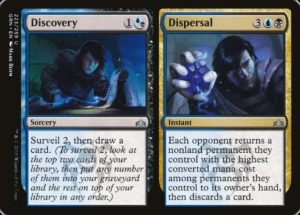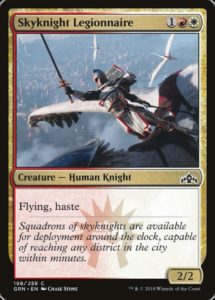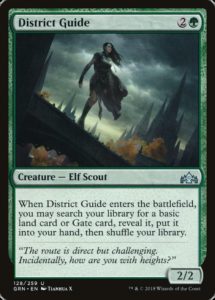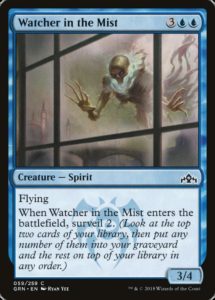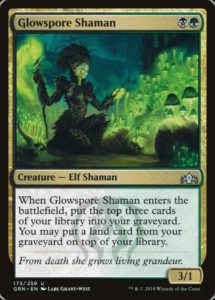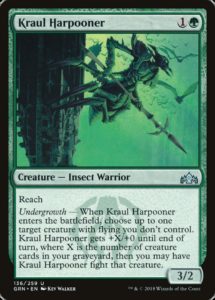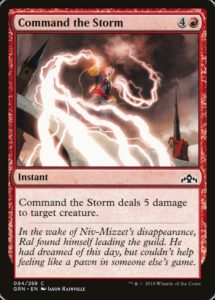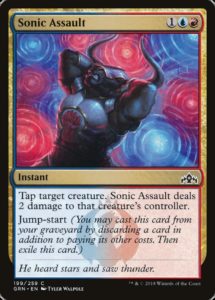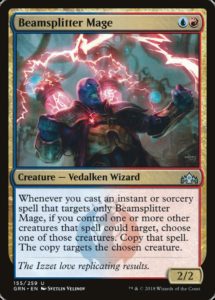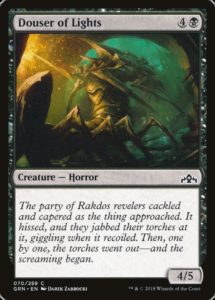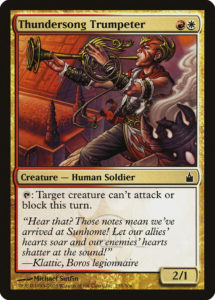Last week Hipsters’ first editor-in-chief, Hunter Slaton, shot me a message. He wanted to know why Discovery (half of the split card, Discovery // Dispersal) wasn’t a one-mana non-split card, just like Preordain. He further supposed such a card was likely deemed too powerful by Play Design and modified.
The questions Hunter posed are fascinating ones: why are cards made the way that they are? What does this tell us about design as a whole? And how does this help us in Limited?
Today, let’s do a deep dive into the cards of Guilds of Ravnica. We’ll start with Discovery // Dispersal and spend a good bit of time on it, but then check out over a dozen other cards in the set. Let’s go!
The Science of Split
Each half of Discovery // Dispersal is both new and yet familiar. Discovery is obviously Preordain with Surveil. Dispersal is a twist on Recoil—it can circumvent Hexproof, but it loses controlled targeting and the ability to bounce lands. Both of these cards are substantially more expensive than their ancestors: Discovery is twice the cost of Preordain and Dispersal costs a whopping five mana despite being less powerful than Recoil. What gives?
Split cards are modal cards, meaning they give you a choice. Modal cards include incredibly powerful designs such as Abzan Charm, Cryptic Command, and Fiery Confluence. They are more than the sum of their parts, as they allow you to include narrow effects at little deckbuilding cost and to tweak your cards to do what you want them to, when you need them to. Modal cards tend to cost more than their constituent components as you pay extra for the benefit of choice. You can contrast modal cards with their opposite, punisher cards like Browbeat, Vexing Devil, and Risk Factor. Punisher cards are less than the sum of their parts. Sure, you’ll always get something powerful, but your opponent gives you what they want you to have, rather than vice-versa. Still, this entire paragraph is commenting why split cards are extra-expensive skirts Hunter’s wise question: why couldn’t we just have Discovery as its own card?
I believe that Discovery was never designed as a one mana cantrip. Not only is it more efficient a cantrip than black has ever gotten at one mana, but one mana cantrips with deck manipulation (and no condition, like Cerulean Wisps) have proven dangerously powerful. Preordain and Ponder are banned in Modern, and the latter is restricted in Vintage. Brainstorm and Serum Visions are format-defining cards in Legacy and Modern. Even the humble Thought Scour is a powerhouse in Modern, thanks to Delve and Snapcaster Mage. Wizards still prints cantrips, but they tend to be two mana cards like Anticipate, Strategic Planning, Radical Idea, and Chart a Course, all which do just enough work that they can’t cost one mana.
In Discovery // Dispersal, I see the same logic as I see in Sinister Sabotage and Burst Lightning. Counterspell, Lightning Bolt, and Preordain are properly costed, but waaaay too powerful at that cost, so you’ll frequently see more expensive or weaker twists with upside and Standard may never again see these actual, brutally efficient cards ever again. Discovery at one mana would be strictly better than Preordain (as Surveil is slightly stronger than Scry), and that’s just too much power to be putting into Standard at one mana. Better to improve the card and accordingly demand it be more expensive.
Thanks for the great questions, Hunter! Now, on to the rest of the set!
Familiar Faces
Every time Boros got its time in the limelight, Skyknight Legionnaire was there. Every time Convoke has been in a (non-Masters) set, Siege Wurm was there. This is an intelligent move for two reasons: first, it’s sometimes better to reprint something that’s doing good work than to make something new that’s basically the same. (This is the argument that led to Colossal Dreadmaw and Legion Conquistador getting printed in both Ixalan and Rivals of Ixalan). Second, reprints bring familiarity by communicating that yes, this is the same Ravnica you already know—in fact, some of your old friends still live there.
One of the harder things to do as a game designer is to recognize when something isn’t broken, when innovation is more likely to make muddle where your players should be focused than improve the experience. These powerful common reprints do a lot of work on several levels.
Twists on the Familiar
District Guide, Electrostatic Field, and Conclave Guildmage all harken back to previous Ravnica cards, but with twists. District Guide is a slight, strict upgrade of Civic Wayfinder. Conclave Guildmage is a much, much weaker take on Vitu-Ghazi Guildmage (and is now the only Selesnya Guildmage that’s not absolutely game-winning by itself). Electrostatic Field is a mix between two Limited powerhouses: Lobber Crew and Thermo-Alchemist that’s been upshifted to uncommon and traded the majority of its damage output for either a single point of toughness or a one mana discount. (Lobber Crew also has a different, guild-agnostic trigger.)
Just as it was important to see familiar reprints, it’s also valuable to include familiar-looking cards. They give experienced players a subtle pair of puzzles to solve: how do the little tweaks modify the card’s power and how does the different context affect both the core concept? For instance, Electrostatic Field is a much worse kill condition than Lobber Crew because it doesn’t ping every turn (and, as an uncommon, is going to be less frequently available). Moreover, as a two-drop, it’s fighting with Goblin Electromancer, a card that seems much better than it did when it playing alongside Lobber Crew in Return to Ravnica. Jump-start makes its ability relevant twice as often and GRN Izzet seems far more aggressively slanted than did RTR Izzet.
Final Familiar Twists
Watcher in the Mist is an excellent example of a subtle twist with roots outside of Ravnica. It’s a Cloudreader Sphinx that trades a slight improvement on Scry for a more color-committing mana cost and the inability to be splashed.
I’m quite excited to see another common 3/4 flying for five mana in blue. We’ve only ever had three: Cloudreader Sphinx, Shimmerscale Drake, and Prescient Chimera. Once upon a time, cards like Aven Windreader were among the best common creatures in a set. Since then, common creatures have gotten bigger and more aggressively costed, making flying sometimes a liability because it usually adds an entire mana to a card’s cost. It’s nice to see that the rising tides of creature stats are raising all boats and we may see more playable blue five drop fliers (and tweaks on Wind Drake) from here on out.
Fixing without Shuffling
Shuffling is problematic. It slows down tournament play, enables ridiculous manabases when fetchlands exist, and is perhaps the single most daunting activity for first-time Magic players. However, mana-fixing and ramp are important, and Rampant Growth, Lay of the Land, or Cultivate require shuffling. The last several years have seen several forays into shuffle-less tutoring, such as Satyr Wayfinder and restricted-Impulse cards like Militia Bugler.
Glowspore Shaman plays in a similar space to Corpse Churn, where you might not always know what you could get, but you’ll know exactly when she can’t miss. Unlike Satyr Wayfinder, the effect is stapled to a relevant set of stats (though she’ll never draw you a card, fills your graveyard with one fewer card, and is much harder to cast on curve). Glowspore Shaman isn’t doing anything completely new, but the combination of an aggressive two drop, self-milling, and color-fixing has never been done before.
A nagging question in my mind is why three cards? Two is too little to guarantee hitting a land and four is enough to almost certainly guarantee it. I don’t know why she gets to look at three cards, Militia Bugler sees four, Elvish Rejuvinator sees five, and Aetherworks Marvel and Collected Company see six. Some of this determination is hard math, some of it is intuition and playtesting, and sometimes it’s a consequence of how powerful Play Design wants a card to be.
In this particular case, I think Play Design has been pretty conservative on self-mill because it’s been problematic developmentally in the past and would make Undergrowth too easy to use. I think this is the same reason that graveyard hate in Standard is so weak at present—they want Golgari mages to be able to utilize their graveyards, but not do so so swiftly that the lack of scorched-earth graveyard hate makes for another problem the size of Emrakul, the Promised End.
A bit of a mess
Kraul Harpooner isn’t a particularly clean execution of a concept. The idea is cute—there’s a sentry waiting on high, and when it jumps down to join your team, it might try and skewer some bird in the process. Unfortunately, making such a card function according to Magic’s rules requires some word soup (not to mention the awkwardness of giving a creature a pump ability it’ll never be able to use in normal circumstances). I like the design of a modal Leaf Arrow that’s alternatively a creature (and when your opponent has an one-power flier, gives you both halves), but the execution isn’t clean.
Also, did you know that the only previous 3/2 Reach was Avatar of the Resolute? I sure didn’t when I sat down to write. It’s always neat when you realize how rare some abilities are in conjunction with extremely common stats.
How do they keep designing new burn spells?!
By all rights, we should be out of original ideas for burn spells. We’ve been getting twenty five years of them, but nevertheless simple designs like Command the Storm and Electrify keep showing up. I adore common moderate removal spells and Command the Storm is a solid addition to red’s slate of common five mana removal.
A new Trumpet Blast
It was initially quite surprising that go-wide Boros has no Trumpet Blast and go-wide Selesya has no Charge. Instead, Izzet gets more aggressive than it’s ever been, combining Lava Axe with Frost Breath, and even more card disadvantage. As folks have doubtless already seen, Sonic Assault is an incredibly powerful card despite it being double card disadvantage.
THE MULTIVERSE’S ANGRIEST VEDALKEN
I love how Goblin Electromancer is so much better in Guilds of Ravnica than it was in Return to Ravnica. I love that Sonic Assault is an aggressive/tempo card that wasn’t at all what Izzet was about the last two times. Beamsplitter Mage is less dear to me.
The concept is simple and sweet—double your spells. Copying is one of blue and red’s few overlapping abilities, albeit a complex one. The problem is with Beamsplitter Mage is that it’s such a nonbo with so much else in the set. It only works with combat tricks like Sure Strike, Maximize Velocity, and Maximize Altitude. (You could throw away a Dazzling Lights to Surveil 4, but that’s a mediocre use for a mediocre card.) It encourages you to play bad cards and doesn’t provide you that much of a reward for doing so.
Beamsplitter Mage also exists at the same spot in the curve as Goblin Electromancer, which is such a central card to Izzet decks. Because the angry Vedalken copies spells but doesn’t cast those copies, it doesn’t give your Wee Dragonauts or Electrostatic Field additional triggers. Obviously, Beamsplitter Mage would need to be waaaay more expensive if it straight up copied all of your spells (see Swarm Intelligence for proper costing), but Beamsplitter Mage doesn’t combine with enough cards to deliver on its promise of an alternate strategy.
Beamsplitter Mage encourages players to go down a draft vein that isn’t really supported, which is a very dangerous thing in design. Sure, you could try and double your combat tricks, but you’re not really winning that much more if you’re doing so. Still, it’s a neat design and not a total trap the way that Goblin Warchief was in Dominaria.*
*I think Goblin Warchief is the single worst inclusion in Dominaria. Obviously it’s a boon for Modern and Standard goblin mages, but it looks a whole lot like a signpost uncommon in a set with barely any goblins (Warchief being the only uncommon and of the two commons, Skirk Prospector can’t even be discounted).
…a Vanilla?
Douser of Lights is fascinating because of what it isn’t. Namely, it’s neither Dimir nor Golgari. It doesn’t even show off some other aspect of the guilds as Maniacal Rage and Street Riot do. Instead, it contributes to a sense of unease, that all is not well. The Rakdos are getting predated upon by something that they should recognize.
Normally, it’s good for vanilla commons to communicate some core, simple component of the world. Thornhide Wolves lets you know that Innistrad is dangerous and that wolves are huge there. Colossal Dreadmaw tells you that dinosaurs and pirates exist on Ixalan. Douser of Lights tells you that all is neither well nor as it seems on Ravnica. Looking further, cards like Hunted Witness, Murmuring Mystic, and Sinister Sabotage suggest that a conspiracy is afoot. The feeling is further reinforced by the guildgates’ flavor text.
This kind of environmental storytelling is something Magic has gotten quite good at over the years, serving to both reinforce the Story Spotlight cards and communicate the story’s themes to people who might not know or pay attention to them.
That’s all for today, friends. Hope you’ve enjoyed this dive into Ravnican design—I sure have.
And, as always, thanks for reading!
—Zachary Barash
Zachary Barash is a New York City-based game designer and the commissioner of Team Draft League. He designs for Kingdom Death: Monster, has a Game Design MFA from the NYU Game Center, and does freelance game design. When the stars align, he streams Magic.
His favorite card of the month is Vedalken Entrancer. It’s a grindy, grindy card, combining reasonable but unexciting stats with a weak ability that can nevertheless win the game. It functions slowly enough to not take over the game, but its combination of defense and inevitability make for a solid card without being broken.

